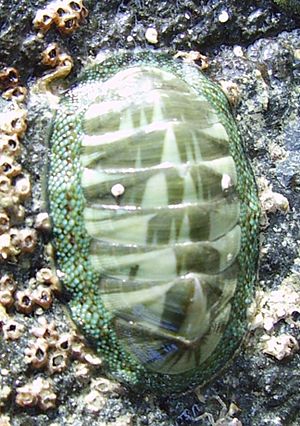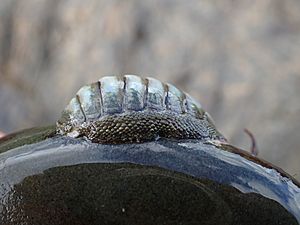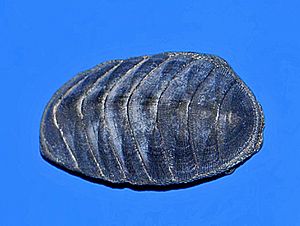Chiton glaucus facts for kids
Quick facts for kids Chiton glaucus |
|
|---|---|
 |
|
| Scientific classification | |
| Genus: |
Chiton
|
| Species: |
glaucus
|
| Synonyms | |
|
|
The Chiton glaucus, also known as the green chiton or blue-green chiton, is a type of chiton. Chitons are amazing sea creatures, a bit like snails, but their shells are made of eight overlapping plates. This chiton is a mollusk that lives in the ocean. It belongs to the family Chitonidae, which includes many common chitons. You can find Chiton glaucus all over New Zealand, where it is the most common chiton species. These ancient animals have been around for a very long time, with fossils showing they existed up to 80 million years ago!
Contents
What Does the Green Chiton Look Like?
Green chitons have an oval shape. They have a slight ridge running down their back, which makes them look the same on both sides. Most of these chitons are about 30 to 35 millimeters long. Some can grow up to 55 millimeters!
Their shell is made of eight plates, called valves. These valves overlap, like roof tiles. There are two special valves at each end and six in the middle. A tough, flexible band called a girdle goes all around the valves. This girdle helps the chiton stick to rocks. For the green chiton, its girdle is covered in large scales.
Usually, the valves and girdle are green. But you might also find chitons that are brown, buff, or even light blue. This is especially true for those living in the North of New Zealand. Sometimes, they have lighter zigzag patterns too. Underneath the chiton's body is a large foot. This foot helps it stick tightly to surfaces. Its gills are hidden on each side of the foot. The chiton has a small, simple mouth at one end of its foot.
Where Do Green Chitons Live?
You can find Chiton glaucus around New Zealand. This includes the North, South, and Stewart Islands, as well as the Chatham Islands. They also live in Tasmania, Australia, especially in estuaries. Scientists think they might have arrived in New Zealand on ships from Australia.
Green chitons love rocky places. They often live on rocks in tide pools. You can find them in areas where the tide goes in and out, or just below the water's surface. They live in many different places, from shores open to big waves to calm, sheltered estuaries. In estuaries, they often hide under shells and stones, like cockles. This helps them stay safe from predators during the day. In more open areas, they live on stones and cobbles. Surprisingly, these chitons can even live in muddy areas and places with some pollution.
Life Cycle of the Green Chiton
We don't know a lot about chiton habits in general. But we have learned some things about how they reproduce. Early studies suggested some chitons might spawn (release eggs and sperm) during a full moon. However, later research showed that chitons usually spawn at the same time, but it's not always linked to the moon or sun.
Male and female chitons are separate. They release their sperm and eggs from a simple organ near their foot. Chiton larvae do not swim freely for long distances. This means they don't spread out very far. After an egg is released, it floats in the water for about two days. Then, it hatches. The larva then changes into a tiny chiton. Its valves and a special feeding part called a radula start to form.
The tiny chiton changes from a long shape to an oval shape. It is only about 0.5 millimeters long. At this stage, it has seven shell valves. About a month later, the eighth valve appears. The young chiton also has two red spots that disappear when it grows up. If the chiton avoids predators, it will grow into an adult and the life cycle will repeat.
What Do Green Chitons Eat?
Green chitons have clear daily routines. They hide during the day to avoid animals that might eat them. At night, they move to the tops of rocks. Here, they feed on algae that has grown since the night before.
Scientists have studied what's inside the guts of Chiton glaucus. They found that these chitons mostly eat a type of algae called coralline algae. Other studies suggest they eat a wider range of things. This includes sponges, bryozoans (tiny colonial animals), and other types of algae and diatoms. They eat by scraping these organisms off surfaces.
Who Eats the Green Chiton?
Green chitons have many predators. These include sea stars, crabs, sea snails, birds, and fish. One of their main predators is the oystercatcher bird. All types of New Zealand oystercatchers eat chitons from rocky shores.
Oystercatchers have a clever way to catch chitons. First, they hit the chiton's shell plates with a sharp blow. If that doesn't work, the bird presses on the edge between the chiton's foot and the rock. Then, it uses a scissor-like motion to break the chiton's grip. They keep doing this until the chiton comes off the surface. After removing the valves, the oystercatcher eats the chiton whole.
Some chitons can get a parasite called Minchinia chitonis. This parasite releases tiny spores into all parts of the chiton's body. Scientists don't fully know how, but the parasite can travel through the chiton's digestive system. It can then be released to infect other chitons.
Amazing Chiton Teeth
Recent studies have looked closely at the teeth of Chiton glaucus and other chitons. These studies found that chiton teeth are incredibly hard and stiff. They are some of the toughest natural materials known! Chiton teeth are about three times harder than human tooth enamel. They are also much harder than the shells of other mollusks.
How do they do this? Chiton teeth have a hard outer layer made of magnetite rods. These rods are arranged in a very specific way. Inside, there's a softer core made of iron phosphate. This special design makes the teeth very strong and resistant to wear. By studying these tiny structures, scientists can learn how to make new, super-strong materials. These materials could be used in machines, tools, or even as coatings for medical implants.
Scientists have also noticed that chitons living on open coastlines are often brighter in color. They have richer greens, yellows, and blues compared to those found in estuaries.



